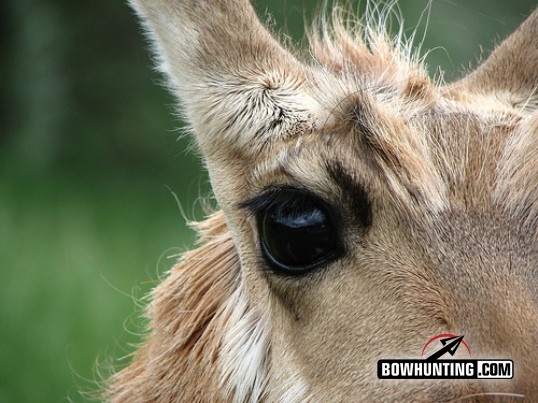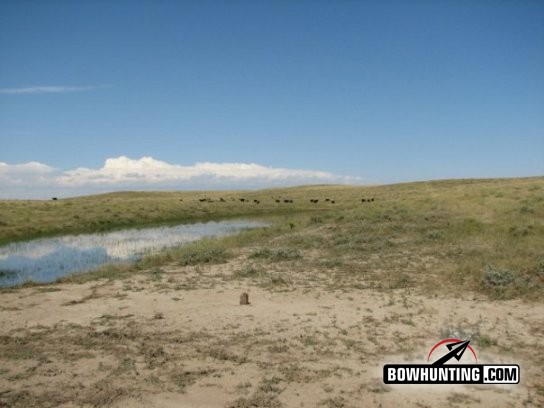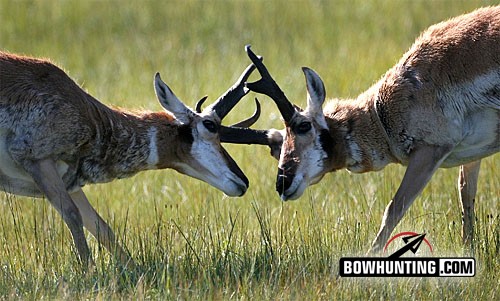LAST UPDATED: May 8th, 2015
With over one million pronghorn (nicknamed antelope) in the American West, most of which inhabit Wyoming and Montana, one would assume that these animals would be an easy kill. However, thinking like this can have you eating tag soup for years to come. These animals are highly specialized to live in their vast prairie environment. Their incredible eye sight allows them to pick up movement as far as three miles away which the human eye would require at least a 6 power binocular lens to acquire.
Along with its eyes used to spot predators, antelope also have speed on their side to out run them. An adult antelope can reach speeds of up to 60 mph and maintain 30 mph speeds for miles if necessary. Catching one is a near impossibility for most predators unless said predator is a 125 grain bullet. However, when you’re launching arrows at the quick footed antelope, you need to change your approach. There are several different methods to hunt antelope but most people choose to use a blind on a waterhole. Spot and stalk is also popular especially combined with the use of antelope decoys.
Deciding where you’re going to set up your antelope blind is no different than picking a good tree for your deer stand. There are a lot of factors that go into your blind placement including location, wind direction, type of blind and timing.
Finding a good water hole is a must because like every other animal on the planet, speed goats need water and in the high mountain deserts these animals inhabit, sometimes it can be hard to find. Watching the antelope in your area will tell you what time of day they are moving into water and how long they stay there. Because these animals have such a large territory, however, you may never see the same goat twice but you can get a good idea of what’s going on in your hunt area by doing some scouting.
Wind direction is an obvious key factor because as we know all too well, your scent can bust you more than most anything else. The wind in the area I hunt generally comes out of the southwest (and in Wyoming, the wind is always blowing) so it’s usually a good idea to try to set up a blind on the northeastern side of a water hole. Obviously because the wind can change direction at anytime this isn’t fool proof but it can be helpful information to have and deserves a little research.
Choosing what blind you want to hunt from is as personal of a choice as any of the equipment we use but there are definitely some that work better than others. Because there isn’t the advantage of trees when hunting the sage goat, a full blind is much better than a partial blind. A group of antelope can easily come up on your back side which will then require you to hold solid until they are able to get you out of their line of site. The Bone Collector blind from Ameristep is a good design because its venting system allows for a little bit more air movement which can be a lifesaver when enduring mid August temperatures that reach into the 90’s. The blind’s dull finish also reduces the reflection of the sun which is essential when trying to outsmart an animal with such good eyesight.
When you set up your blind is also very important. Because it’s not something that’s going to blend in what so ever as it sits alone alongside the water hole, you want to set it up early. The antelope will notice something new has moved into the neighborhood but if it’s there for several weeks and doesn’t present a threat, they will get used to it and it won’t bother them.
Because not everything needs to be made a beer drinking sport like blind hunting sometimes is, the spot and stalk method will get you on your feet or even your hands and knees and keeps you moving all day. As has already been mentioned, the antelope’s eyes are nothing short of amazing and will most likely spot you long before you know the goat’s location. A good pair of binoculars will give you a much needed edge and is essential to looking out over the plains in hopes to find your big buck. The Leupold Cascades 10×42 binocular have proved in the past to hold up to the winds and dust of the west which are known to be hard on equipment. Sage brush doesn’t lend much coverage so the terrain will fast become your friend. Big bucks who don’t have does in tow will try to get on a higher point or edge of a ridge in order to scope the landscape for predators and threats. No matter how good they can see though, they still don’t have eyes in the back of their head and putting a sneak on their back side while they lay in the sun is a good way to get an advantage. When reaching within the 50-70 yard range, dropping to your knees and sometimes even belly crawling is going to be required in order to stay out of their line of vision.
If crawling through cactus, sage brush, thistles and rocks doesn’t sound like a good time, employing the use of a decoy such as the Carrylite EZ Goat Antelope Decoy can also be useful. If you’re within 60 yards or so the buck will notice the decoy and will start to get uneasy. Throughout most of the year, antelope maintain a peaceful herd but during breeding season, the bucks can get a little wound up. Dominant bucks will have patience for subordinate bucks at water holes and out in the open but they fast lose them if the smaller buck thinks he’s going to move in on the does. Mature antelope bucks will charge a smaller buck in order to get rid of it and when he’s packing 120 pounds behind a 50 mph punch, he can definitely do a lot of damage.
Most antelope decoys come with labels warning people not to stand behind the decoy but I can’t stress the seriousness of this warning. People don’t realize how fast these animals can move and will not necessarily mean to be standing behind the decoy when a buck has charged them. Basically, the best recommendation is to set up and get out of the way which is not only safer but will provide a much better shot.
Whether you choose to wait out the antelope in the hot summer sun or put your body through pain as you crawl over cactus, successful antelope hunting isn’t always easy. Picking the right equipment is important and knowing the land of your hunt area is key, but having patience and a plan is what will get you your goat.










